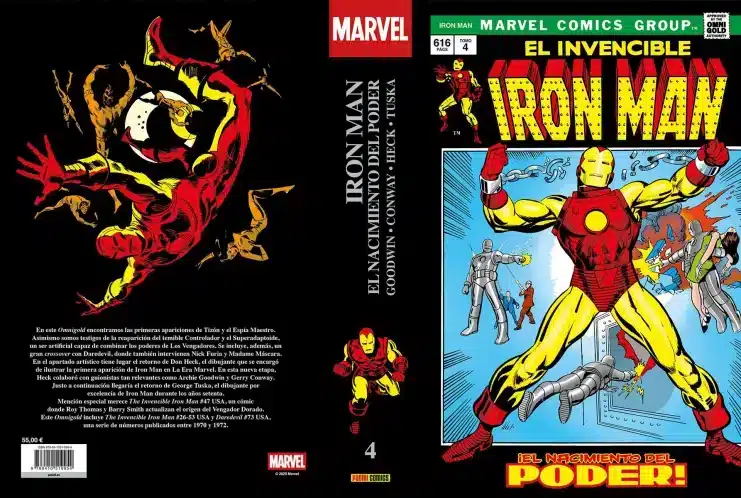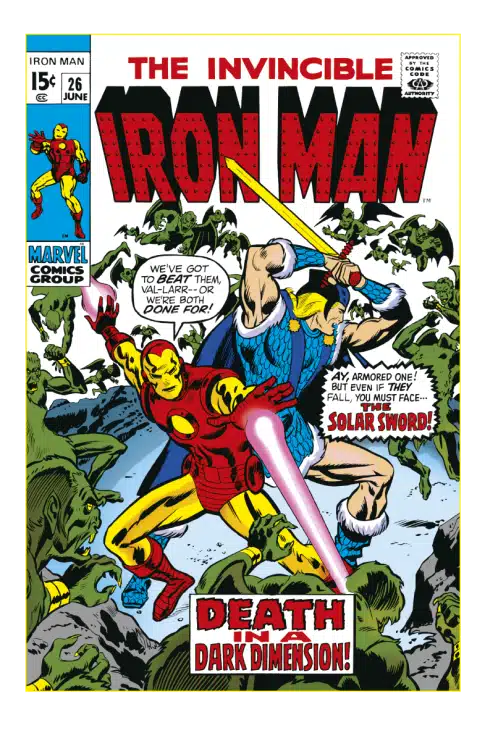

In a new volume of Iron Man’s Marvel Gold Line, the fourth published by Panini Comics, we discovered the best of Don Heck’s phase in the position of the series
There is no doubt that today Iron Man Is one of the main ramparts of Marvel ComicsBut when his fame has just crossed the readers’ barrier of The house of ideas (Before UCM) He had the honor of being one of those characters who had been there from the beginning, collecting enough success to get to date without disappeared periods. Among the many authors who have left their mark in the early years of the character, it could be highlighted among others Don DiamineThe main protagonist of the fourth volume (the first half is almost whole) of the line Marvel Gold dedicated to the character, now published by Panini Comics.


A clear unprotected phase
There are phases that age well and others that simply age. This room took Marvel Gold from Iron Man, which collects most of the adventures of Golden Avenger Between 1970 and 1972 it is a cocktail of both. On the one hand it is a somewhat clumsy reflection, although sometimes captivating, of an editorial that was in full transition and that did not know very well if I wanted to tell stories for children or enter more adults and politicians who come off.
The first thing to know when you open this Tocho is that you will not find a saga of master or a cohesive arch. No. This is a parade of authors and cartoonists with makeshift disparities. Some give everything and others are simply there. And in the midst of all this, Tony Stark The storm is falling like Can, intertwined in industrial conspiracy, operetta dictators, recycled aliens of science fiction pulpFolletin novels and many secondary ones who enter and leave as if the series was a rotating door.


The irregular avenger
Let’s start with a batch of car -branded stories that seem to be taken from the bottom of a drawer. Some are regulators and others directly forgetable. There is one with him Controller This is allowed to read, but others like the Dark size or from Solar sword They seem to be written quickly and without desire. The funny thing is that from time to time there is an idea that with better execution would have worked much better. This happens, for example, with the presentation of TizónA villain with an anti -system speech that sounds like a booklet of the institute, but at least tries to get out of the usual.
In the part of the script with which we started Archie Goodwin (Obviously not in your best version, nothing to do with your work for example in Creeping) Until you say goodbye and takes a parade of writers with different luck. Mimi Gold signs a soft cartoon and a little bad taste on a company governed by a car, and then enters Allyn BrodskyThis seems to want to do many things at the same time but it is not up to par. Try KaijusRobot, street protests and bad guys who hate progress but stories, although with curious ideas, do not end to bask. Sometimes it seems that Iron Man entered a science fiction anthology of the 1950s (not the best precisely) without knowing how it arrived there.
But not everything is irregular. In the middle of chaos it appears Kevin O’BrienAn impulsive engineer who gradually earns importance and whose evolution will lead to one of the best sagas of the volume, that Custodian. But before getting there you have to go through a transition phase in which Gerry Conway Take the reins and create a plot rooted with spies, secret organizations, classic bad and a passage Daredevil It seems more an editorial apaño than something planned. The problem here is not ambition, but saturation. There are so many characters and so many subtrams that the reader ends up getting lost. In addition, there is an excess of plot that does not lead anywhere in which everything above imports to import because a new more mysterious and more dangerous group appears and starts again.
Fortunately, after that mess the aforementioned Guardian saga arrives, which is well built. Here Tony’s personal drama is mixed with betrayals, jealousy, madness and an environment of growing tension. Kevin, that secondary that seemed passing through, ends up transforming into a tragic and complex figure. The thing becomes serious and the story advances with an claw. Marianne RodgersStark’s new romantic interest also becomes relevant and not only as an ornament, but with his conflict, since he has strange mental powers and does not know very well what to do with it.
All this part has a much darker and more mature tone, and finally it seems that the collection finds a course. Even when the screenwriter changes in the middle of the arch (Conway gives the site to Robert Kanigher and then a Gary Friedrich) The story continues to work because there seems to be a clear idea and this always helps.
Of course, when this solid phase ends, the volume returns to the streets. The latest stories end up being extraordinarily boring, to the point of supposing a challenge for the reader who wants to achieve his end. The filling returns, with small inspired aliens, bad ridiculous and plots that go anywhere. There is also a number that looks like a soap economic work, with Tony and Marianne fighting as if they were jealous teenagers. And when it seems that the thing cannot go worse, the Python Princess Tony’s kidnapping and ask for a rescue as if this were a chapter of Scooby-doo.


Diamine y tuska
In the design Don Heck returns after an absence of the series and remains for some time to do his best, being the main cartoonist of the first half of the volume and becoming the most precious of this. Then insert George Tusk And it will take over. Tuska has his things: he is a dynamic and solvent -narrative artist, but his style does not always fit well to the tone of the stories. It also passes through Barry Windsor-Smith In a special number that reinvents the origin of the character with its characteristic detailed and elegant line, a breath of fresh air.
In short, this volume is a Russian quality mountain. There are numbers that are ashamed of others and others who surprise from their emotional burden and their more adult approach. If one takes it as a sample of the transition comic of superheroes, when a definitive voice was still sought in Marvel Comics in the 70s, the volume has its grace. And for the complex reader it is an important piece in the evolution of Iron Man as a character. But for those who wait a coherent reading, with large epic sagas, perhaps this is not the best volume to read. Here you have to come with the right chip and enjoy the good, laugh a little bad and evaluate how, between bankrupt ideas and bad thirds, the personality of one of the Avengers more emblematic.
Is this the best classic iron? Nor joke. Do you have moments that justify reading? Obviously. Him Volume Posted by Panini Comics On the rigid cover it contains 616 color pages with a size of 17 x 26 cm. and includes the translation of numbers #26 to #53 The invincible iron man and the #73 of Daredevil. The recommended sale price is € 55 and was offered for sale in June 2025.


Marvel Gold. Iron Man 4
Don Heck, one of the fundamental artists of Iron Man, returns for a new dose of action. And how! Let’s start with a journey into the dark dimension of the collector, followed by Firebrand, a villain with the unmistakable political burden of the seventies and a clash with the controller who presents the debut of Howard Stark, Tony’s father. A revolution in Latin America, giant monsters and mechanical visitors of the outdoor space are accompanied in this volume, in which a passage takes place with Daredevil and rediscovered the origin of the Iron man through Roy Thomas and Barry Smith, among other points of interest.
Authors: Roy Thomas, Mike Friedrich, Gerry Conway, Barry Windsor-Smith, Allyn Brodsky, Archie Goodwin, Don Heck, Gary Friedrich, Gene Coran, George Tuska, Mimi Gold, Jim Mooney y Robert Kanigher

